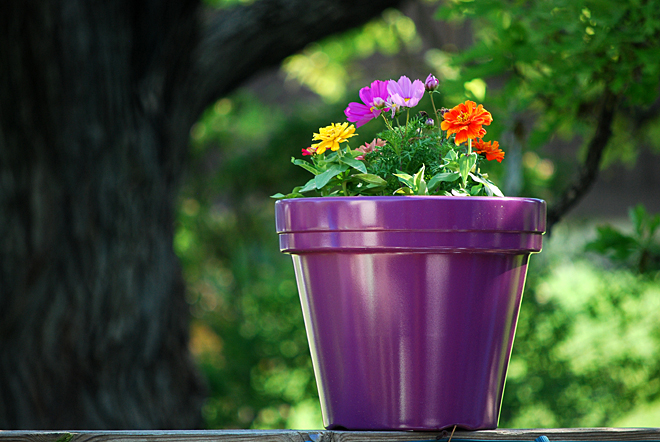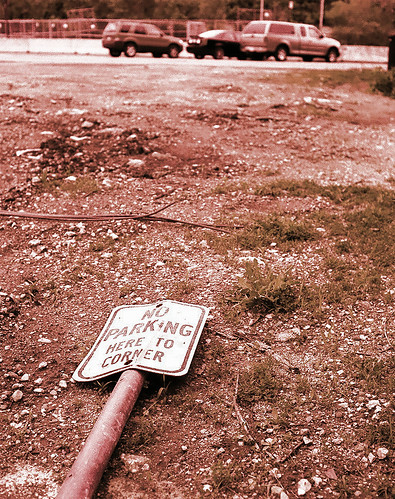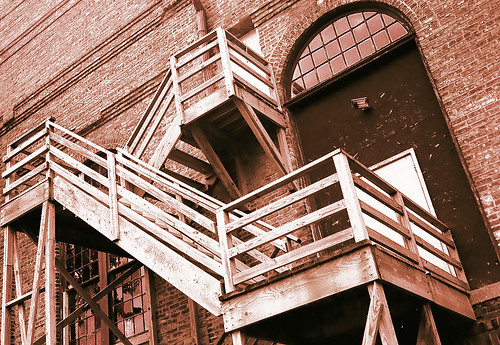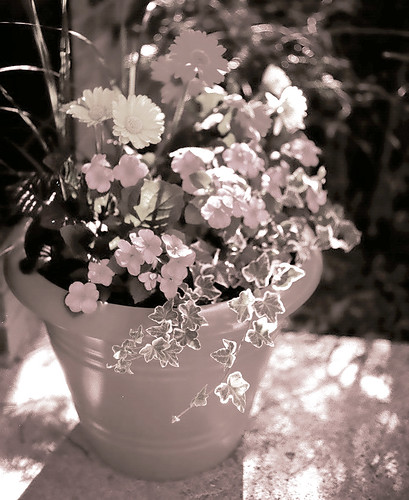
A purple pot of pleasant posies placed precariously on a perch. Actually, a deck rail in my backyard. I was out in my yard in the late afternoon looking for Mr. Goodlight with a 70-200mm zoom attached to my camera. Found him lurking under the shade of the old oak tree behind my house.
Aperture priority, wide open, 200mm, let the camera make the call on the exposure. No major post processing, just a couple of levels adjustments.
What else is blooming: I received an e-mail from Getty Images yesterday afternoon. Getty is in a partnership with Flickr to troll the photos in the Flickrverse for inclusion in their library of stock images. The e-mail informed me that Getty had selected two dozen of my Flickr photos and gave a link to their web site where I could enroll as a contributor.
So far, about 8,800 Flickr members have taken Getty Images up on their offer. Getty is one of the biggest players in the stock photo business, so it can't hurt to have them behind a few of my photos. So make that about 8,801 Flickr members being represented by Getty. We'll see how that pans out.
New toy! I like classic cameras and got one as a gift yesterday (from someone who visits this blog on a regular basis -- you know who you are -- thank you very much). Being involved with photography, I get a lot of people who approach me and start a conversation with, "I don't know if you can use this, but ..." Then they present me with "this."

"This" is a Canon Canonet GIII QL17. A camera with a name bigger than the camera itself. Canon introduced the camera in 1972, and it sold for about $90, which translates to around $400 in today's money, about what you can get a new Nikon D40 for. What you got for the money back then was a very decent camera that actually had more features than today's D40.
The GIII is film camera (obviously) with rangefinder focus and a fast 1.7 40mm lens. A hotshoe mount syncs the flash on all shutter speeds, which range from 1/4 to 1/500 second. An internal metering system allows full automatic exposure or you can go manual. The light sensor is built into the lens, which saves on having to compensate the exposure setting when using filters. The camera has a bulb setting for long exposures and a pc synch outlet for off camera flash. The shutter button accepts a cable release. The GIII picked up the nickname "poor man's Leica" after it appeared on the market, because its capabilities mimicked those of the much more expensive camera at a savings of about $1,000.
I'm planning on buying a roll of film and a new battery to try it out this weekend.
The photo is of my gift Canonet. You can click on the image to enlarge. Taken with my Nikon D60 which doesn't synch flash at all speeds, doesn't accept a cable release and has no pc synch. But I'm not bitter. Photographs © 2009 James Jordan.


















